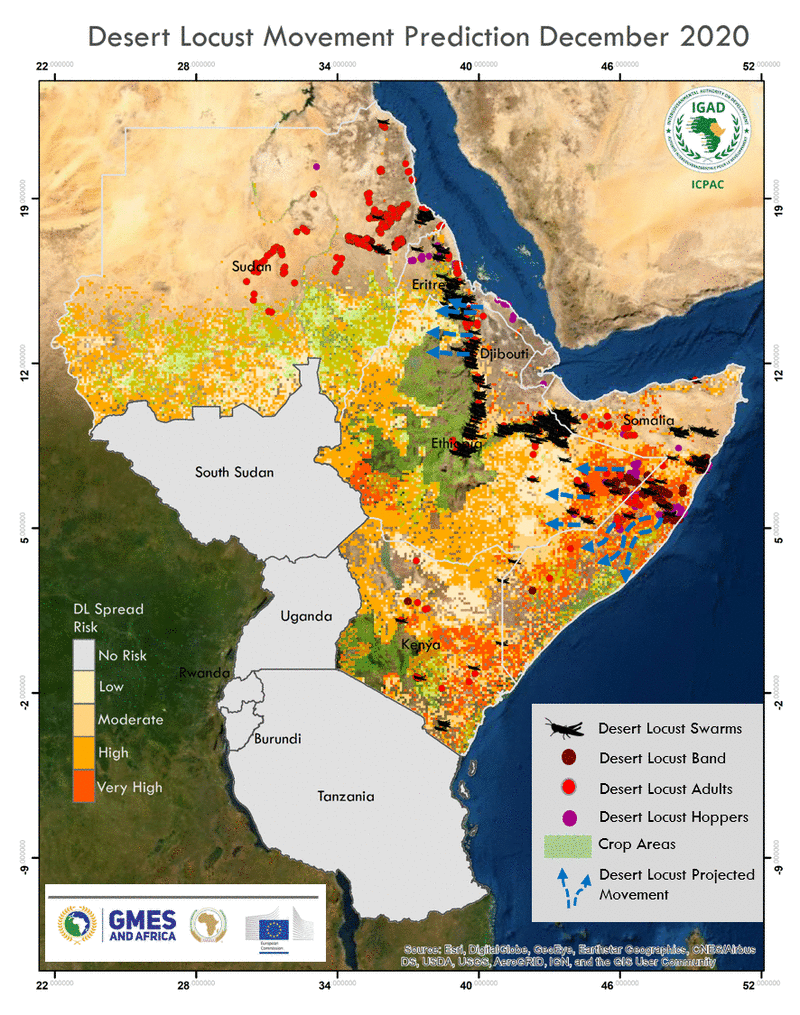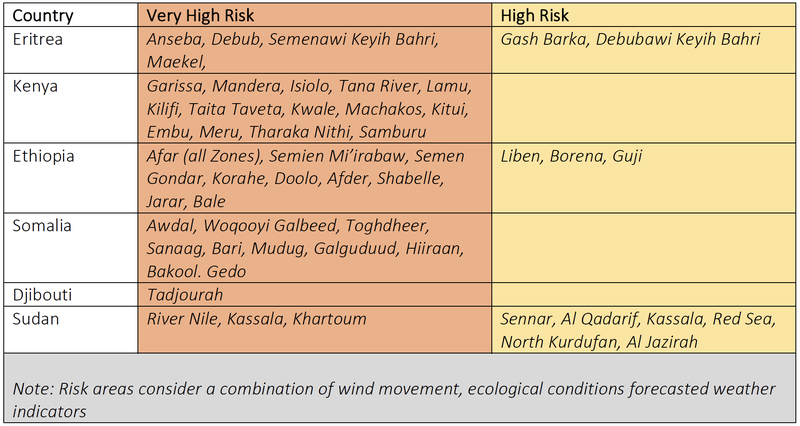Desert Locust Projection December 2020
Very high risk of significant impacts to both crops & rangelands due to high rainfall received

Projected impact on food and fodder
- Very high risk of significant impacts to both crops and rangelands due to high rainfall received in northern parts of the region which has enabled the swarms to migrate. Cyclone Gati brought heavy rainfall to Somalia and is likely to increase vegetation biomass. This has the potential of increasing locust numbers due to surplus vegetation.
- Above-average rainfall in Sudan, northern Ethiopia and northern Somalia continues to cause favourable conditions for locust breeding and development thus increasing numbers of swarms even with control measures.
Desert Locust Spread
- In the current desert locust invasion areas of the region, locust swarms have been reported in the last 6 weeks in north-eastern, eastern, and coastal regions of Kenya; central, north, north-eastern and eastern Ethiopia; north-western, north-eastern and central Somalia; north-eastern Sudan and highland areas of Eritrea.
- Adult locusts are in large numbers in Sudan, Eritrea, Ethiopia, and Somalia, areas that received high rainfall and that have good vegetation cover. These are showing high reproduction and rapid development. There continues to be a large number of swarms even with control efforts in both northern, central, and eastern Ethiopia and central and northern Somalia.
Forecasted climatic and ecological conditions
- Climatic conditions suitable for desert locust development are forecast to be highly suitable in eastern and coastal Kenya, eastern Ethiopia, central and southern Somalia.
- Ecological conditions, particularly the availability of green vegetation, are most suitable in the northern subregion due to the higher than usual rainfall received during the season which continues to sustain vegetation growth. This is a likely driver as to why the locust invasion continues to be in high intensity in Ethiopia's Rift Valley, Eritrea's Debubawi; Sudan’s River Nile, Red Sea and Kassala; Somalia's Woqooyi Galbeed, Sol, Bari, Nugaal, Mudug and Galguduud.
- Wind direction and speeds, which greatly determine swarm movement, are forecasted to be northeasterly in Somalia likely to favor southward and westward locust movement for the mature swarms. Northern Ethiopia, Eritrea, and northern Sudan have wind direction forecasted to favor northwards and northwest locust swarm movements.
- Adult desert locusts have been reported in the following locations: Woqooyi Galbeed, Togdheer, Sool, Galguduud Somalia, along Rift Valley and Ahmar mountains Ethiopia, Northern Kurfufan, Northen, River Nile and Red Sea Sudan, and Debub Eritrea. This indicates recent breeding and locust development in those areas.
Desert locusts are projected to move from:
- Galguduud and Mugud to Hiiraan, Shabeelle, Jubba and Bay regions of Somalia
- Ethiopia Doolo, Korahe, Shabelle and Jarar to Nogob, Afder and eastern Bale.
- Deubawi, Mehakeleghaw and Misraqawi Ethiopia to Gash Barka Semenawi Keih Bahri parts of Eritrea
- Intermittent multi-directional winds may favor swarms to move in varying directions during the projection period.
Highest risk areas
Highest risk areas for Desert Locust swarms and adult locust invasion based on forecasted climate conditions and existing vegetation suitable for an invasion are outlined below:

